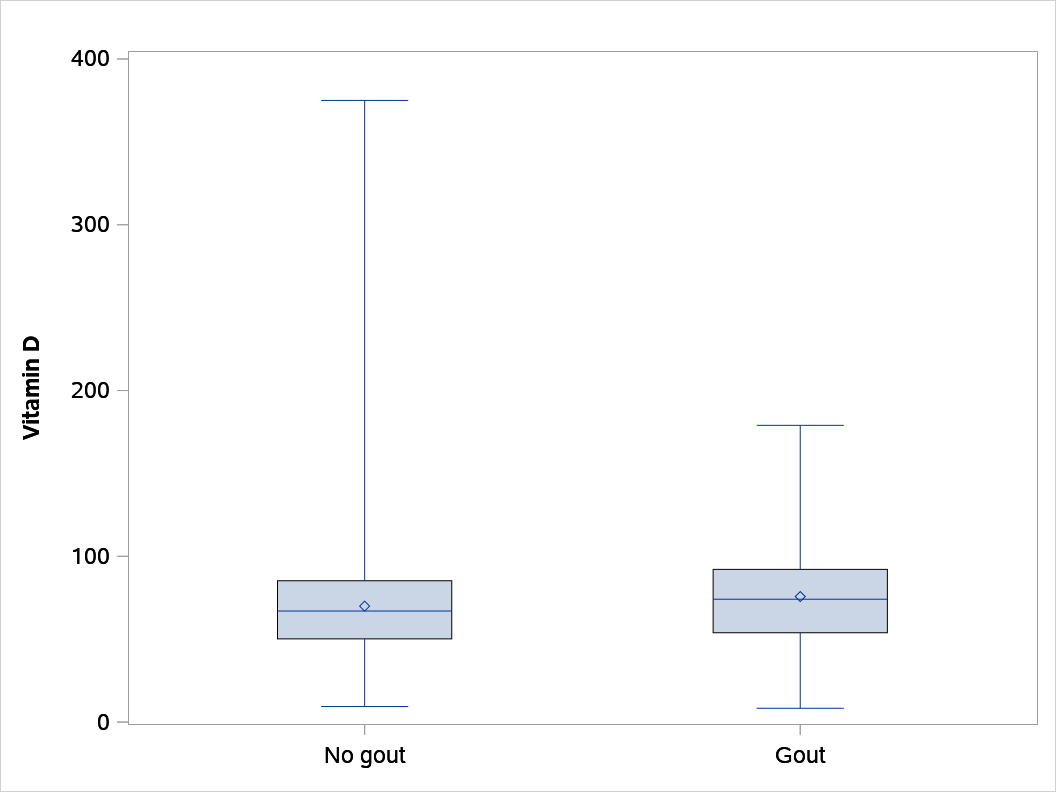Session Information
Date: Tuesday, November 12, 2019
Title: Epidemiology & Public Health Poster III: OA, Gout, & Other Diseases
Session Type: Poster Session (Tuesday)
Session Time: 9:00AM-11:00AM
Background/Purpose: Prior research showed conflicting results about the association of vitamin D with gout. We aimed in this study to quantify vitamin D levels in patients with and without gout using nationally representative data.
Methods: The National Health and Nutrition Examination Survey (NHANES) is a nationally representative sample of the non-institutionalized population in the United States. We analyzed data from 2011 to 2014 for adults (age ≥20 years). Gout was defined as a “yes” to: “Has a doctor or other health professional ever told you that you had gout?”. Gender, age, vitamin D level, and vitamin D supplement use in the past 30 days were identified. Vitamin D deficiency was defined as < 50 nmol/L and high vitamin D level was defined as >125 nmol/L. Survey-specific statistical methods were used to account for sample design. Mean vitamin D levels (with 95% CI) and low/high vitamin D prevalence were calculated for people with and without gout. The Chi-square test was used to test the difference between categorical variables with alpha=0.05.
Results: There were 10,907 adults in our sample, which represented 226,559,243 people when weighted. Gout was reported in 8,705,906 (3.8%) of the sample. The mean age was 60.8 (95% CI:59.0-62.6) in those with gout compared to 49.9 (CI:46.0-47.8) in those without gout. 67.3% of those with gout were male compared to 47.2 % in those with no gout. Mean vitamin D level was 75.7 (95% CI:71.4-80.1) in people with gout compared to 69.9 (95% CI:67.8-72.1) in those without gout (see Figure 1). The prevalence of low vitamin D in people with and without gout were 25.2% and 27.7%, respectively (P value 0.3945). While the prevalence of high vitamin D level in people with and without gout were 6.4% and 4.3, respectively (P value 0.1265). Vitamin D supplement use was more common in people with gout (50.3%) compared to people without gout (40.4%, P value 0.0025). Among people with gout who took vitamin D supplements, 40.0% reported being advised by a doctor to take the supplement.
Conclusion: In this large nationally representative population-based cross-sectional study, vitamin D was not associated with gout. The prevalence of vitamin D deficiency was similar in people with and without gout. Vitamin D supplement use was more common in people with gout.
To cite this abstract in AMA style:
Al-Naqeeb J, Saeed M, Dye B, Jeranko M. Association of Gout with Vitamin D: A Population-Based Study [abstract]. Arthritis Rheumatol. 2019; 71 (suppl 10). https://acrabstracts.org/abstract/association-of-gout-with-vitamin-d-a-population-based-study/. Accessed .« Back to 2019 ACR/ARP Annual Meeting
ACR Meeting Abstracts - https://acrabstracts.org/abstract/association-of-gout-with-vitamin-d-a-population-based-study/

